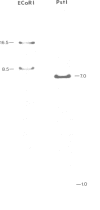Abstract
We have constructed a genomic library of homozygous b4b4 rabbit DNA in the pJB8 cosmid vector. Clones containing Ckappa-like sequences were screened with a b4 cDNA probe and were characterized by restriction mapping. One of the clones contained a Ckappa sequence different from the b4 allotype normally expressed by the animal. We report here the nucleotide sequence of this gene and show that it probably corresponds to a kappa-bas form of the Basilea allotype. It appears to be a structurally complete gene without any stop codons within the coding region and containing the dinucleotide AG as a splice site acceptor for the J-C junction, just 5' of the coding block. Comparison with the b4 cDNA nucleotide sequence shows a separate evolution of the Ckappa-coding and 3'-untranslated sequences, since the 3'-untranslated regions are more conserved than the coding regions. Genomic blot analysis would suggest that the kappa-bas gene is isotypic in the domestic rabbit population, since it lies within a genomic EcoRI or PstI restriction fragment, which was shown to be common to all homozygous b4, b5, b6 and b9 rabbit DNAs.
Full text
PDF
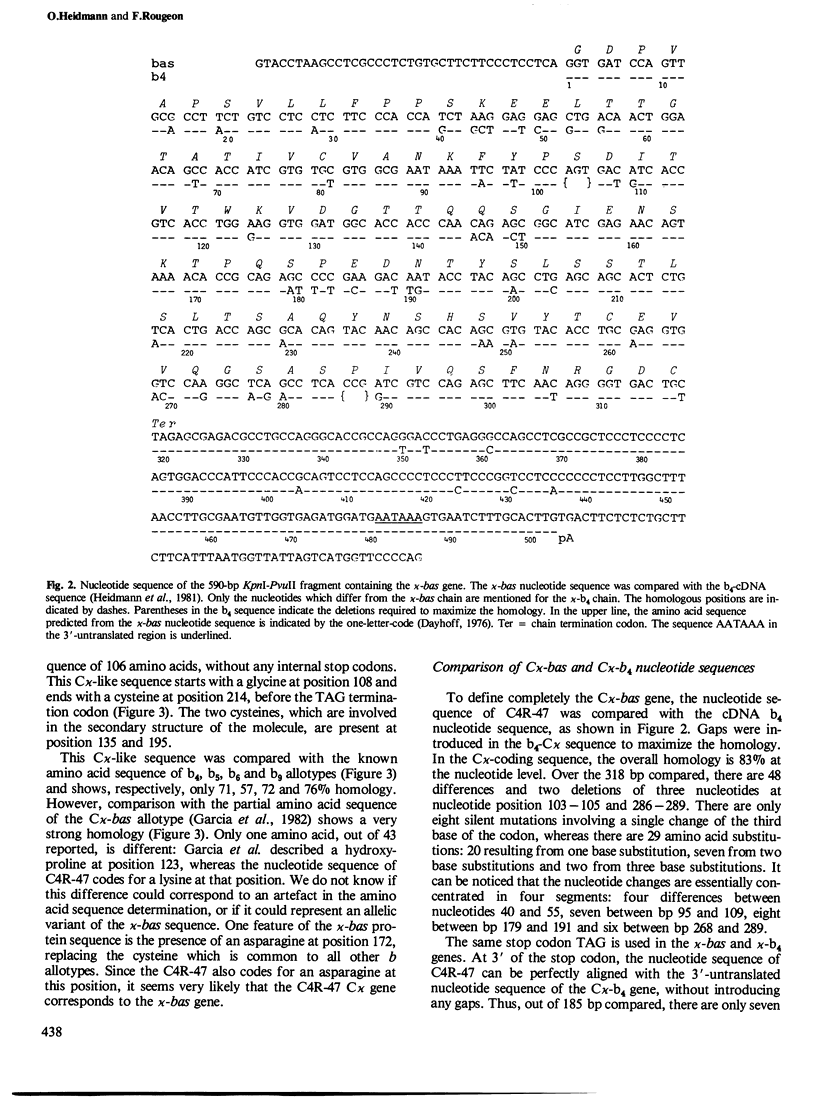
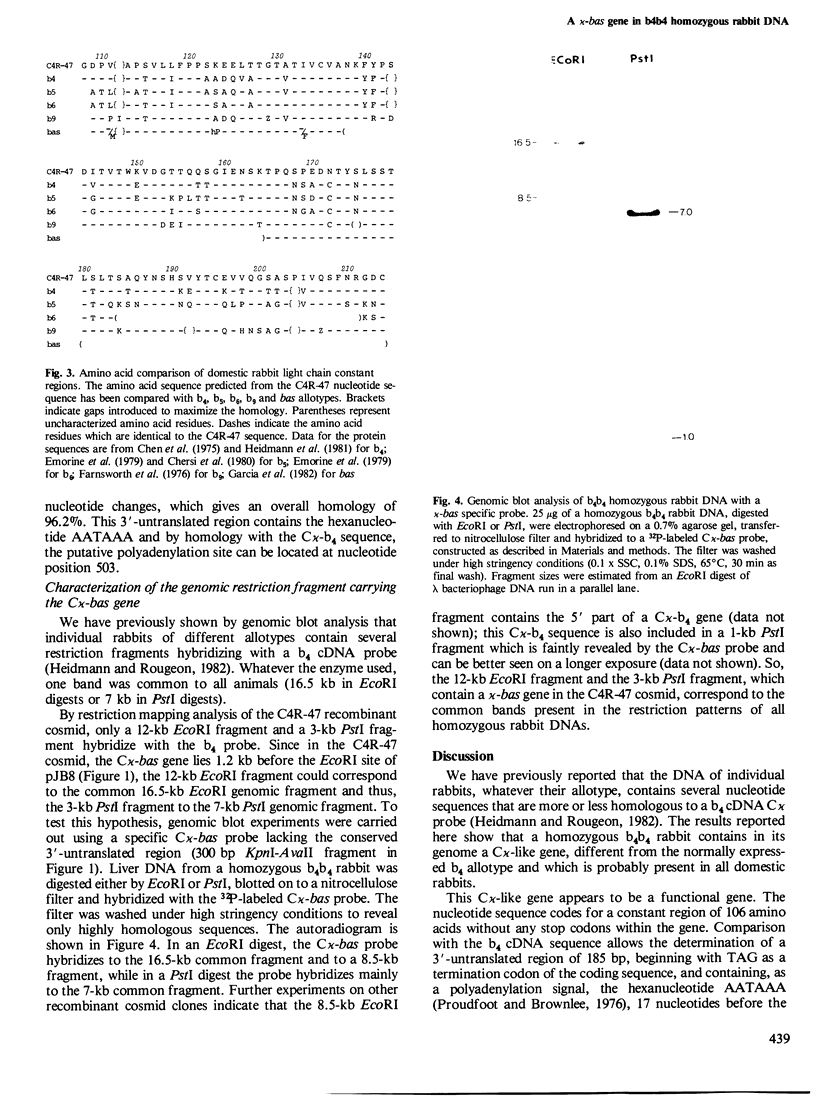
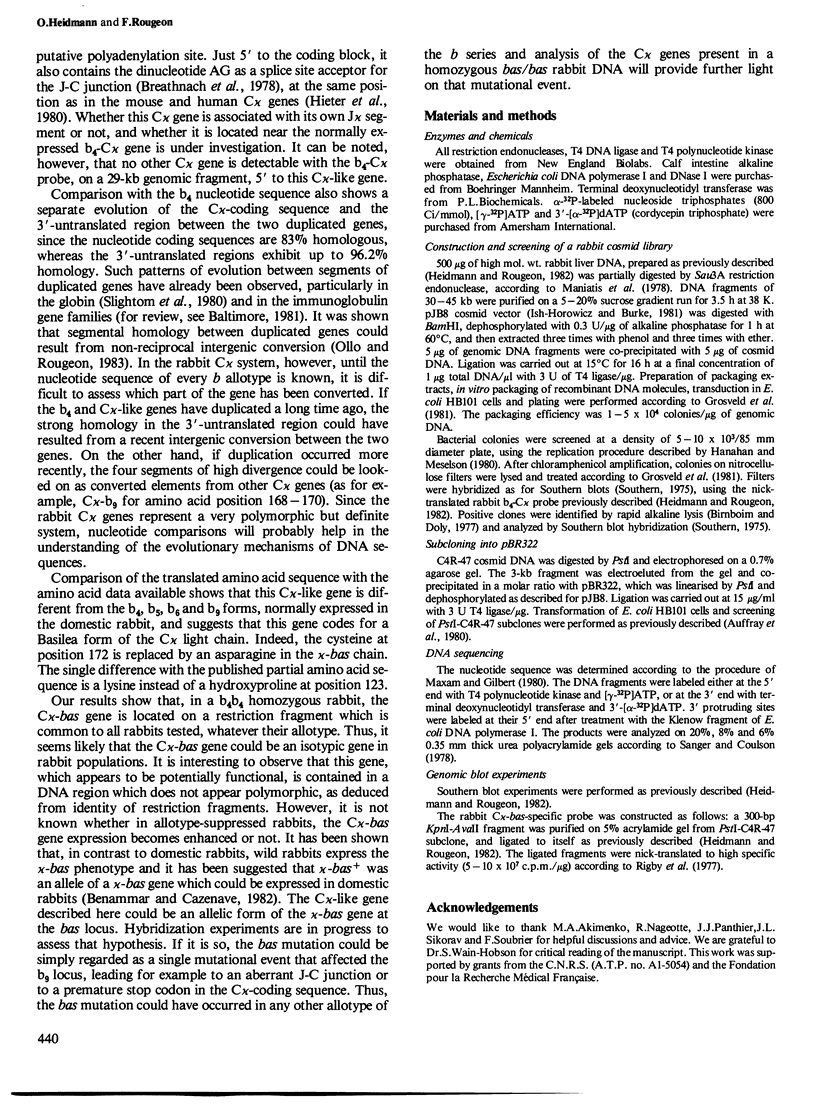
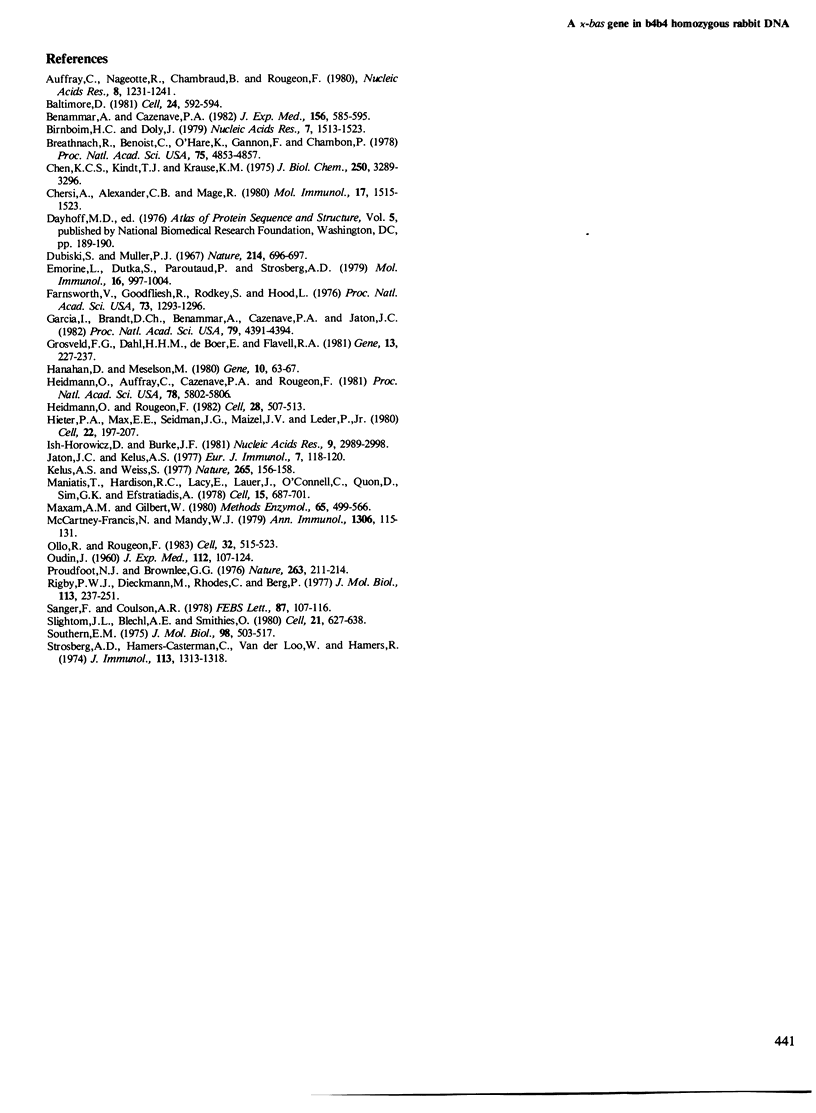
Images in this article
Selected References
These references are in PubMed. This may not be the complete list of references from this article.
- Auffray C., Nageotte R., Chambraud B., Rougeon F. Mouse immunoglobulin genes: a bacterial plasmid containing the entire coding sequence for a pre-gamma 2a heavy chain. Nucleic Acids Res. 1980 Mar 25;8(6):1231–1241. doi: 10.1093/nar/8.6.1231. [DOI] [PMC free article] [PubMed] [Google Scholar]
- Baltimore D. Gene conversion: some implications for immunoglobulin genes. Cell. 1981 Jun;24(3):592–594. doi: 10.1016/0092-8674(81)90082-9. [DOI] [PubMed] [Google Scholar]
- Benammar A., Cazenave P. A. A second rabbit kappa isotype. J Exp Med. 1982 Aug 1;156(2):585–595. doi: 10.1084/jem.156.2.585. [DOI] [PMC free article] [PubMed] [Google Scholar]
- Birnboim H. C., Doly J. A rapid alkaline extraction procedure for screening recombinant plasmid DNA. Nucleic Acids Res. 1979 Nov 24;7(6):1513–1523. doi: 10.1093/nar/7.6.1513. [DOI] [PMC free article] [PubMed] [Google Scholar]
- Breathnach R., Benoist C., O'Hare K., Gannon F., Chambon P. Ovalbumin gene: evidence for a leader sequence in mRNA and DNA sequences at the exon-intron boundaries. Proc Natl Acad Sci U S A. 1978 Oct;75(10):4853–4857. doi: 10.1073/pnas.75.10.4853. [DOI] [PMC free article] [PubMed] [Google Scholar]
- Chen K. C., Kindt T. J., Krause R. M. Primary structure of the L chain from a rabbit homogeneous antibody to streptococcal carbohydrate. II. Sequence determination of peptides from tryptic and peptic digests. J Biol Chem. 1975 May 10;250(9):3289–3296. [PubMed] [Google Scholar]
- Chersi A., Alexander C. B., Mage R. Partial primary structure of the immunoglobulin light chain constant region of a single rabbit of b5 allotype. Mol Immunol. 1980 Dec;17(12):1515–1523. doi: 10.1016/0161-5890(80)90177-7. [DOI] [PubMed] [Google Scholar]
- Dubiski S., Muller P. J. A "new" allotypic specificity (A9) of rabbit immunoglobulin. Nature. 1967 May 13;214(5089):696–697. doi: 10.1038/214696a0. [DOI] [PubMed] [Google Scholar]
- Emorine L., Dutka S., Paroutaud P., Strosberg A. D. The structural correlates of the rabbit light chain b allotypes: sequence studies of b5 and b6 chains. Mol Immunol. 1979 Dec;16(12):997–1004. doi: 10.1016/0161-5890(79)90033-6. [DOI] [PubMed] [Google Scholar]
- Farnsworth V., Goodfliesh R., Rodkey S., Hood L. Immunoglobulin allotypes of rabbit kappa chains: polymorphism of a control mechanism regulating closely linked duplicated genes? Proc Natl Acad Sci U S A. 1976 Apr;73(4):1293–1296. doi: 10.1073/pnas.73.4.1293. [DOI] [PMC free article] [PubMed] [Google Scholar]
- Garcia I., Brandt D. C., Benammar A., Cazenave P. A., Jaton J. C. BASILEA rabbits express two types of immunoglobulin light chains: lambda and kappa-like. Proc Natl Acad Sci U S A. 1982 Jul;79(14):4391–4394. doi: 10.1073/pnas.79.14.4391. [DOI] [PMC free article] [PubMed] [Google Scholar]
- Grosveld F. G., Dahl H. H., de Boer E., Flavell R. A. Isolation of beta-globin-related genes from a human cosmid library. Gene. 1981 Apr;13(3):227–237. doi: 10.1016/0378-1119(81)90028-7. [DOI] [PubMed] [Google Scholar]
- Hanahan D., Meselson M. Plasmid screening at high colony density. Gene. 1980 Jun;10(1):63–67. doi: 10.1016/0378-1119(80)90144-4. [DOI] [PubMed] [Google Scholar]
- Heidmann O., Auffray C., Cazenave P. A., Rougeon F. Nucleotide sequence of constant and 3' untranslated regions of a kappa immunoglobulin light chain mRNA of a homozygous b4 rabbit. Proc Natl Acad Sci U S A. 1981 Sep;78(9):5802–5806. doi: 10.1073/pnas.78.9.5802. [DOI] [PMC free article] [PubMed] [Google Scholar]
- Heidmann O., Rougeon F. Multiple sequences related to a constant-region kappa light chain gene in the rabbit genome. Cell. 1982 Mar;28(3):507–513. doi: 10.1016/0092-8674(82)90205-7. [DOI] [PubMed] [Google Scholar]
- Hieter P. A., Max E. E., Seidman J. G., Maizel J. V., Jr, Leder P. Cloned human and mouse kappa immunoglobulin constant and J region genes conserve homology in functional segments. Cell. 1980 Nov;22(1 Pt 1):197–207. doi: 10.1016/0092-8674(80)90168-3. [DOI] [PubMed] [Google Scholar]
- Ish-Horowicz D., Burke J. F. Rapid and efficient cosmid cloning. Nucleic Acids Res. 1981 Jul 10;9(13):2989–2998. doi: 10.1093/nar/9.13.2989. [DOI] [PMC free article] [PubMed] [Google Scholar]
- Jaton J. C., Kelus A. S. Peptide mapping of the lambda-like chains of the BASILEA rabbits. Eur J Immunol. 1977 Feb;7(2):118–120. doi: 10.1002/eji.1830070212. [DOI] [PubMed] [Google Scholar]
- Kelus A. S., Weiss S. Variant strain of rabbits lacking immunoglobulin kappa polypeptide chain. Nature. 1977 Jan 13;265(5590):156–158. doi: 10.1038/265156a0. [DOI] [PubMed] [Google Scholar]
- Maniatis T., Hardison R. C., Lacy E., Lauer J., O'Connell C., Quon D., Sim G. K., Efstratiadis A. The isolation of structural genes from libraries of eucaryotic DNA. Cell. 1978 Oct;15(2):687–701. doi: 10.1016/0092-8674(78)90036-3. [DOI] [PubMed] [Google Scholar]
- Maxam A. M., Gilbert W. Sequencing end-labeled DNA with base-specific chemical cleavages. Methods Enzymol. 1980;65(1):499–560. doi: 10.1016/s0076-6879(80)65059-9. [DOI] [PubMed] [Google Scholar]
- McCartney-Francis N., Mandy W. J. Serological and chemical studies of latent allotypes in the rabbit. Ann Immunol (Paris) 1979 Mar-Apr;130(2):115=31–115=31. [PubMed] [Google Scholar]
- OUDIN J. Allotypy of rabbit serum proteins. I. Immuno-chemical analysis leading to the individualization of seven main allotypes. J Exp Med. 1960 Jul 1;112:107–124. doi: 10.1084/jem.112.1.107. [DOI] [PMC free article] [PubMed] [Google Scholar]
- Ollo R., Rougeon F. Gene conversion and polymorphism: generation of mouse immunoglobulin gamma 2a chain alleles by differential gene conversion by gamma 2b chain gene. Cell. 1983 Feb;32(2):515–523. doi: 10.1016/0092-8674(83)90471-3. [DOI] [PubMed] [Google Scholar]
- Proudfoot N. J., Brownlee G. G. 3' non-coding region sequences in eukaryotic messenger RNA. Nature. 1976 Sep 16;263(5574):211–214. doi: 10.1038/263211a0. [DOI] [PubMed] [Google Scholar]
- Rigby P. W., Dieckmann M., Rhodes C., Berg P. Labeling deoxyribonucleic acid to high specific activity in vitro by nick translation with DNA polymerase I. J Mol Biol. 1977 Jun 15;113(1):237–251. doi: 10.1016/0022-2836(77)90052-3. [DOI] [PubMed] [Google Scholar]
- Sanger F., Coulson A. R. The use of thin acrylamide gels for DNA sequencing. FEBS Lett. 1978 Mar 1;87(1):107–110. doi: 10.1016/0014-5793(78)80145-8. [DOI] [PubMed] [Google Scholar]
- Slightom J. L., Blechl A. E., Smithies O. Human fetal G gamma- and A gamma-globin genes: complete nucleotide sequences suggest that DNA can be exchanged between these duplicated genes. Cell. 1980 Oct;21(3):627–638. doi: 10.1016/0092-8674(80)90426-2. [DOI] [PubMed] [Google Scholar]
- Southern E. M. Detection of specific sequences among DNA fragments separated by gel electrophoresis. J Mol Biol. 1975 Nov 5;98(3):503–517. doi: 10.1016/s0022-2836(75)80083-0. [DOI] [PubMed] [Google Scholar]
- Strosberg A. D., Hamers-Casterman C., Van der Loo W., Hamers R. A rabbit with the allotypic phenotype: ala2a3 b4b5b6. J Immunol. 1974 Oct;113(4):1313–1318. [PubMed] [Google Scholar]



